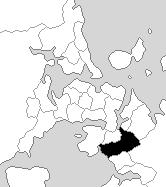Related Research Articles
Arch Hill was one of 80 electorates in New Zealand between 1946 and 1954. Located in central Auckland, the electorate was considered a safe seat for the Labour Party in its eight years of existence.
Piako was a New Zealand parliamentary electorate established in 1946 and disestablished in 2008. It was last held by Lindsay Tisch MP from 2002 to 2008.

Rodney was a New Zealand parliamentary electorate, returning one Member of Parliament to the House of Representatives. The last MP for Rodney was Mark Mitchell of the National Party. He held this position from 2011 until the electorate was replaced with Whangaparāoa in 2020. Mitchell stood for and won that seat.
Hauraki is a former New Zealand parliamentary electorate, from 1928 to 1987 and 1993 to 1996. In the 1987 general election it was renamed Coromandel, the name that had been used from 1972 to 1981. In 1993 it reverted to Hauraki, but became Coromandel again for the first MMP election in 1996.
Hamilton is a former New Zealand parliamentary electorate that existed from 1922 to 1969. The electorate covered the urban area of the city of Hamilton. In 1969, the city was part of two rural electorates, Hamilton East and Waikato. For the 1972 election, the nature of Hamilton East changed to urban, and the Hamilton West electorate complements it to form a second urban electorate.
Petone is a former parliamentary electorate in the lower Hutt Valley of New Zealand, from 1946 to 1978. The electorate was represented by two Members of Parliament from the Labour Party.
Waimarino was a New Zealand parliamentary electorate that existed from 1911 to 1954, and from 1963 to 1972. It was rural in nature and was represented by four Members of Parliament.

Panmure is a former New Zealand parliamentary electorate in the southern suburbs of the city of Auckland, from 1984 to 1996. In the four parliamentary terms of its existence, it was first represented by Bob Tizard of the Labour Party, and then by his daughter Judith Tizard.
Otahuhu is a former New Zealand parliamentary electorate in the southern suburbs of the city of Auckland, from 1938 to 1963, and then from 1972 to 1984.
Franklin was a rural New Zealand parliamentary electorate. It existed from 1861 to 1996 during four periods.

Birkenhead was a New Zealand Parliamentary electorate on Auckland's North Shore from 1969 to 1996, when it was absorbed into the Northcote electorate.
Hobson is a former New Zealand parliamentary electorate. It existed from 1946 to 1978 and then from 1987 to 1996, and was represented by five Members of Parliament, four of whom represented the National Party. It is notable for returning a member of the Social Credit Party in the 1966 election, as no other candidate not aligned with either Labour or National had been elected to Parliament since 1943. With the re-drawing of boundaries in the first MMP election in 1996, the seat was absorbed into the Northland and Whangarei electorates.

Otara was a New Zealand parliamentary electorate in Auckland, from 1984 to 1996. It existed for four parliamentary terms and was represented by three members of parliament, two from Labour and one from National.
West Auckland is a former New Zealand parliamentary electorate on the western outskirts of Auckland, created for the 1984 election from part of the former Helensville electorate. The electorate was abolished for the 1993 election, and split between Henderson and Waitakere electorates.
Chalmers, originally Port Chalmers, was a parliamentary electorate in the Otago Region of New Zealand, from 1866 to 1938 with a break from 1896 to 1902. It was named after the town of Port Chalmers, the main port of Dunedin and Otago.
Mornington is a former parliamentary electorate from 1946 to 1963, centred on the suburb of Mornington in the city of Dunedin, New Zealand.
Parnell was a parliamentary electorate in the city of Auckland, New Zealand, from 1861 to 1954, with one break of eight years.
Auckland North was a parliamentary electorate in Auckland, New Zealand, from 1881 to 1890.
Waimate was a parliamentary electorate in the Canterbury region of New Zealand from 1881 to 1893 and from 1946 to 1957. It was represented by three Members of Parliament.
Franklin South was a parliamentary electorate in the southern part of the Auckland Region of New Zealand from 1881 to 1890. During the three parliamentary terms of its existence, the electorate was represented by Ebenezer Hamlin.
References
- McRobie, Alan (1989). Electoral Atlas of New Zealand. Wellington: GP Books. ISBN 0-477-01384-8.
- Wilson, James Oakley (1985) [First published in 1913]. New Zealand Parliamentary Record, 1840–1984 (4th ed.). Wellington: V.R. Ward, Govt. Printer. OCLC 154283103.
- Norton, Clifford (1988). New Zealand Parliamentary Election Results 1946–1987: Occasional Publications No 1, Department of Political Science. Wellington: Victoria University of Wellington. ISBN 0-475-11200-8.